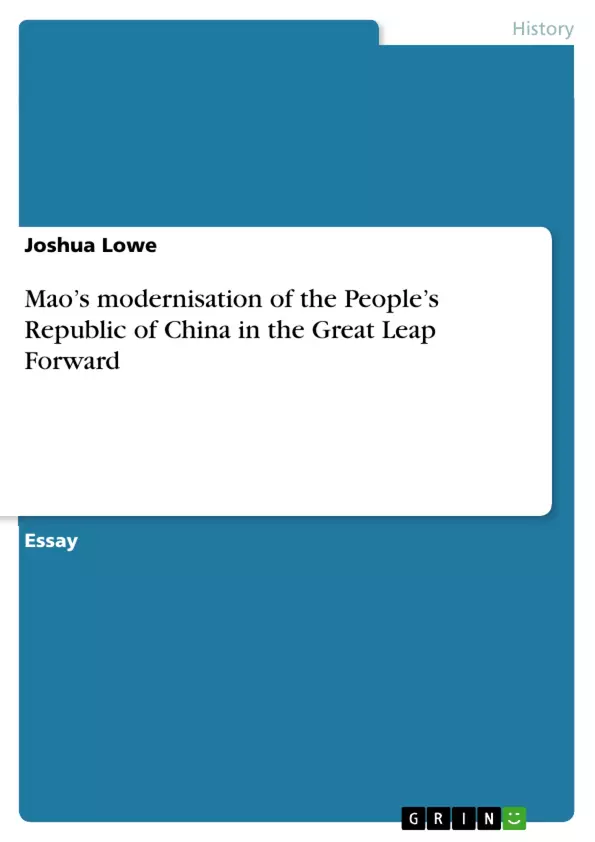Chairman Mao made two major attempts to modernise the People’s Republic of China with the Great Leap Forward from 1958 to 1962 and the Cultural Revolution from 1966 to 1976. Stuart Schram presents the view that these modernisation attempts were poorly planned and led to disastrous outcomes. Other historians such as Roger Howard suggest that Mao had a strong political consciousness and understanding of the needs of his people. This essay will explore the two major modernisation attempts, making reference to the thoughts of Chairman Mao as a server of the people and why his modernisation attempts may have been more detrimental rather than beneficial to his nation.
Was Mao’s modernisation of the People’s Republic of China in the Great Leap Forward (1958-62) and the Cultural Revolution (1966-76) a success of failure? (Minor Essay)
Chairman Mao made two major attempts to modernise the People’s Republic of China with the Great Leap Forward from 1958 to 1962 and the Cultural Revolution from 1966 to 1976. Stuart Schram presents the view that these modernisation attempts were poorly planned and led to disastrous outcomes.[1] Other historians such as Roger Howard suggest that Mao had a strong political consciousness and understanding of the needs of his people.[2] This essay will explore the two major modernisation attempts, making reference to the thoughts of Chairman Mao as a server of the people and why his modernisation attempts may have been more detrimental rather than beneficial to his nation.
The Great Leap Forward was an attempt to modernise China’s economic structure from an agricultural system into an industrial one. Mao intended to create a non-Soviet model for economic expansion using the rural peasant class rather than the urban peasant class that Soviet Russia had used yet China lacked.
The Great Leap Forward gave working class people their first major experience of socialist construction.[3] A backyard furnace industry, smelting iron and steel was encouraged. There was a minor success to this as ordinary people were familiarised with the industrial process.[4] It also helped garner support for Mao from the rural peasant class as they were entrusted with helping build up the industry of the People’s Republic of China.
However, this process wasn’t a great leap forward. It was more of a mediocre hop of little progress. By 1959 these furnaces were only producing a quarter of the projected output of twenty million tons of metal.[5] The metal that was created from this was also not steel, but pig iron. It could not be used as a building material as it would crumble and crack too easily. The backyard furnaces plan may have introduced ordinary people to the industrial system but they lacked the skills to create even average quality metals. This was one of the failures of Mao’s attempt to modernise. He entrusted the rural peasant class to build up his industry without understanding that they lacked the skills to do so. Many tons of metal were wasted on a fruitless endeavour. However, it wasn’t a complete failure as it did bring the population together. Tens of millions of ordinary Chinese people participated.[6]
[...]
[1] Schram, Simon, The Thought of Mao Tse-Tung (Cambridge University Press, 1989), p.195
[2] Howard, Roger, Mao Tse-Tung and the Chinese People (Monthly Preview Press, 1977), p. 197-198
[3] Ibid., p.280
[4] Ibid.
[5] Ibid., p. 308
Frequently asked questions
What is the main topic of this document?
This document is a minor essay discussing whether Mao Zedong's modernization efforts in the People's Republic of China during the Great Leap Forward (1958-62) and the Cultural Revolution (1966-76) were successful or not.
What are the two major modernization attempts mentioned in the essay?
The two major attempts are the Great Leap Forward (1958-1962) and the Cultural Revolution (1966-1976).
What was the Great Leap Forward intended to achieve?
The Great Leap Forward aimed to transform China's economy from an agricultural system into an industrial one, using the rural peasant class.
What was the "backyard furnace" industry?
It was an initiative during the Great Leap Forward where ordinary people were encouraged to smelt iron and steel in backyard furnaces.
Was the backyard furnace industry successful?
The document suggests it was a minor success in familiarizing people with the industrial process and garnering support for Mao, but ultimately failed due to the poor quality of the metal produced (pig iron) and the lack of necessary skills among the participants.
What are the different views of historians on Mao's modernization attempts?
Stuart Schram views the attempts as poorly planned and leading to disastrous outcomes. Roger Howard suggests Mao had a strong political consciousness and understanding of the needs of his people.
What is the document's conclusion on the success of the Great Leap Forward?
The document implies that the Great Leap Forward was more of a "mediocre hop of little progress" rather than a "great leap forward" because it did not have the desired impact of creating a functional industrial system for China.
What is the author's primary argument?
The author is exploring why Mao's modernisation attempts might have been more detrimental than beneficial to the Chinese nation.
- Arbeit zitieren
- Joshua Lowe (Autor:in), 2013, Mao’s modernisation of the People’s Republic of China in the Great Leap Forward, München, GRIN Verlag, https://www.hausarbeiten.de/document/266231


